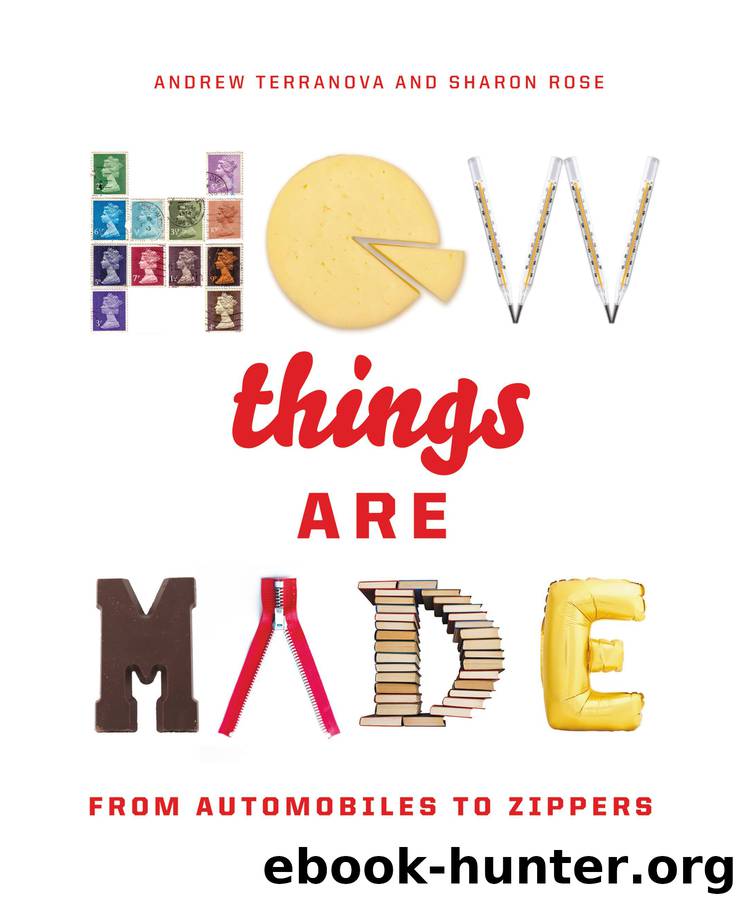How Things Are Made by Andrew Terranova & Sharon Rose

Author:Andrew Terranova & Sharon Rose
Language: eng
Format: epub
Publisher: Running Press
Published: 2018-02-12T16:00:00+00:00
Through the Glass
One of the most remarkable characteristics of optical fiber is that it can hold a strong signal and carry it over a long distance without allowing it to weaken.
An optical fiber is a single, hair-fine filament (thread) drawn from molten silica glass or extruded from plastic. These fibers change information into light pulses, which are then transmitted along the fiber-optic cable. Since about the 1970s, communications providers have been building networks with optical fiber. Compared to copper wire, optical fiber carries information faster, takes up much less space, and doesn’t suffer from any interference or static from nearby electrical wires.
Optical fiber has already replaced almost all copper wire connections for long-haul communications networks, including the Internet backbone. Increasingly, fast fiber-optic Internet connections are available right to your home. About 25 percent of the United States has fiber to the home available, though that figure varies wildly, depending on where you live.
Hundreds of undersea optical fiber cables carry 99 percent of the communications between countries, and many more optical fibers provide communications over land. Optical fiber is used to carry Internet, phone, and television signals, and for network communications within the world’s data centers. Optical-fiber technology is also used for medical and dental instruments (e.g., endoscopy), optical sensors for mechanical inspections, communications within automobile systems, specific power transmission applications (e.g., where electrical isolation is required), and even for lighting and decorations.
Alexander Graham Bell, the American inventor best known for developing the telephone, first attempted to communicate by using light around 1880. However, light-wave communication did not become possible until the mid-twentieth century when advanced technology provided a transmission source, the laser, and an efficient medium, the optical fiber. The laser was invented in 1960 and, six years later, researchers in England discovered that silica glass fibers would carry light waves without significant attenuation, or loss of signal. In 1970, a new type of laser was developed, and the first optical fibers were commercially produced.
In a fiber-optic communications system, cables made of optical fibers connect datalinks that contain lasers and light detectors. To transmit information, a datalink converts analog electronic signals—like those from a telephone conversation or the output of a video camera—into digital pulses of laser light. These travel through the optical fiber to another datalink, where a light detector reconverts them into electronic signals.
Download
This site does not store any files on its server. We only index and link to content provided by other sites. Please contact the content providers to delete copyright contents if any and email us, we'll remove relevant links or contents immediately.
| Coloring Books for Grown-Ups | Humor |
| Movies | Performing Arts |
| Pop Culture | Puzzles & Games |
| Radio | Sheet Music & Scores |
| Television | Trivia & Fun Facts |
Atlas Obscura by Joshua Foer(2350)
The Book Of Lists by Wallechinsky David & Wallace Amy(1847)
The Earth Chronicles Handbook by Zecharia Sitchin(1744)
The Right Way to Do Wrong by Harry Houdini(1620)
Badass Affirmations by Becca Anderson(1601)
The Book of Common Fallacies by Philip Ward Julia Edwards(1297)
The Mystery of the Exploding Teeth by Thomas Morris(1264)
Elephants on Acid: And Other Bizarre Experiments by Alex Boese(1249)
Elephants on Acid by Boese Alex(1234)
Atlas of Improbable Places by Travis Elborough(1192)
A Christmas Cornucopia by Mark Forsyth(1180)
I'm So Full of Happy Today by Martin Andersen & Moira Tuffy(1161)
Big, Bad Book of Botany : The World's Most Fascinating Flora (9780062282767) by Largo Michael(1125)
The Mysteries of Mithra by Cumont Franz(1045)
Breaking History by Sarah Pruitt(1037)
Wild Talents by Charles Fort(1033)
How Things Are Made by Andrew Terranova & Sharon Rose(984)
A Cookie to Celebrate by Jana Douglass(965)
John A Keel by 2002 The Complete Guide to Mysterious Beings(955)
